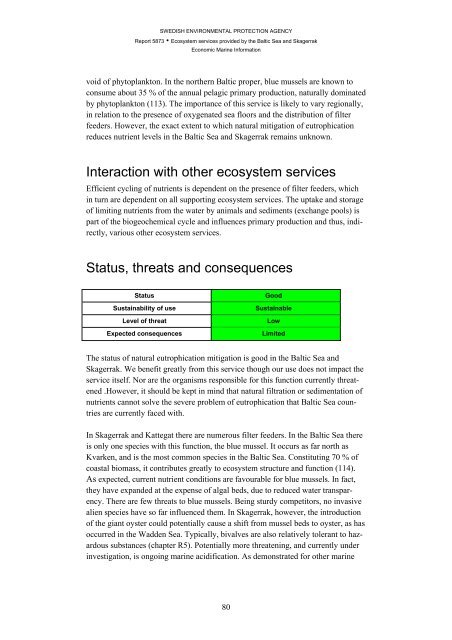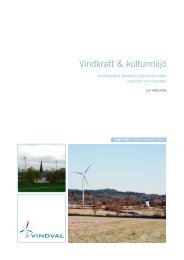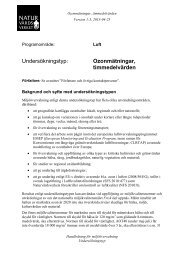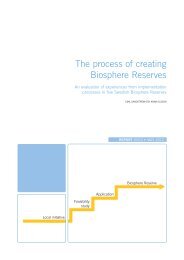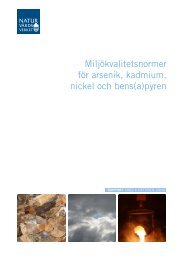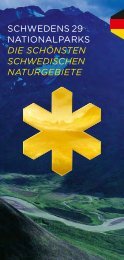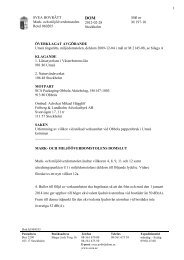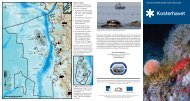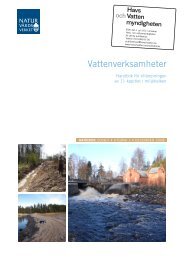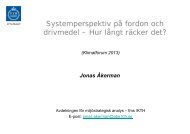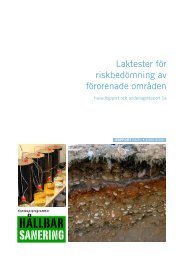Ecosystem services provided by the Baltic Sea ... - Naturvårdsverket
Ecosystem services provided by the Baltic Sea ... - Naturvårdsverket
Ecosystem services provided by the Baltic Sea ... - Naturvårdsverket
Create successful ePaper yourself
Turn your PDF publications into a flip-book with our unique Google optimized e-Paper software.
SWEDISH ENVIRONMENTAL PROTECTION AGENCY<br />
Report 5873 • <strong>Ecosystem</strong> <strong>services</strong> <strong>provided</strong> <strong>by</strong> <strong>the</strong> <strong>Baltic</strong> <strong>Sea</strong> and Skagerrak<br />
Economic Marine Information<br />
void of phytoplankton. In <strong>the</strong> nor<strong>the</strong>rn <strong>Baltic</strong> proper, blue mussels are known to<br />
consume about 35 % of <strong>the</strong> annual pelagic primary production, naturally dominated<br />
<strong>by</strong> phytoplankton (113). The importance of this service is likely to vary regionally,<br />
in relation to <strong>the</strong> presence of oxygenated sea floors and <strong>the</strong> distribution of filter<br />
feeders. However, <strong>the</strong> exact extent to which natural mitigation of eutrophication<br />
reduces nutrient levels in <strong>the</strong> <strong>Baltic</strong> <strong>Sea</strong> and Skagerrak remains unknown.<br />
Interaction with o<strong>the</strong>r ecosystem <strong>services</strong><br />
Efficient cycling of nutrients is dependent on <strong>the</strong> presence of filter feeders, which<br />
in turn are dependent on all supporting ecosystem <strong>services</strong>. The uptake and storage<br />
of limiting nutrients from <strong>the</strong> water <strong>by</strong> animals and sediments (exchange pools) is<br />
part of <strong>the</strong> biogeochemical cycle and influences primary production and thus, indirectly,<br />
various o<strong>the</strong>r ecosystem <strong>services</strong>.<br />
Status, threats and consequences<br />
Status<br />
Sustainability of use<br />
Level of threat<br />
Expected consequences<br />
Good<br />
Sustainable<br />
Low<br />
Limited<br />
The status of natural eutrophication mitigation is good in <strong>the</strong> <strong>Baltic</strong> <strong>Sea</strong> and<br />
Skagerrak. We benefit greatly from this service though our use does not impact <strong>the</strong><br />
service itself. Nor are <strong>the</strong> organisms responsible for this function currently threatened<br />
.However, it should be kept in mind that natural filtration or sedimentation of<br />
nutrients cannot solve <strong>the</strong> severe problem of eutrophication that <strong>Baltic</strong> <strong>Sea</strong> countries<br />
are currently faced with.<br />
In Skagerrak and Kattegat <strong>the</strong>re are numerous filter feeders. In <strong>the</strong> <strong>Baltic</strong> <strong>Sea</strong> <strong>the</strong>re<br />
is only one species with this function, <strong>the</strong> blue mussel. It occurs as far north as<br />
Kvarken, and is <strong>the</strong> most common species in <strong>the</strong> <strong>Baltic</strong> <strong>Sea</strong>. Constituting 70 % of<br />
coastal biomass, it contributes greatly to ecosystem structure and function (114).<br />
As expected, current nutrient conditions are favourable for blue mussels. In fact,<br />
<strong>the</strong>y have expanded at <strong>the</strong> expense of algal beds, due to reduced water transparency.<br />
There are few threats to blue mussels. Being sturdy competitors, no invasive<br />
alien species have so far influenced <strong>the</strong>m. In Skagerrak, however, <strong>the</strong> introduction<br />
of <strong>the</strong> giant oyster could potentially cause a shift from mussel beds to oyster, as has<br />
occurred in <strong>the</strong> Wadden <strong>Sea</strong>. Typically, bivalves are also relatively tolerant to hazardous<br />
substances (chapter R5). Potentially more threatening, and currently under<br />
investigation, is ongoing marine acidification. As demonstrated for o<strong>the</strong>r marine<br />
80


